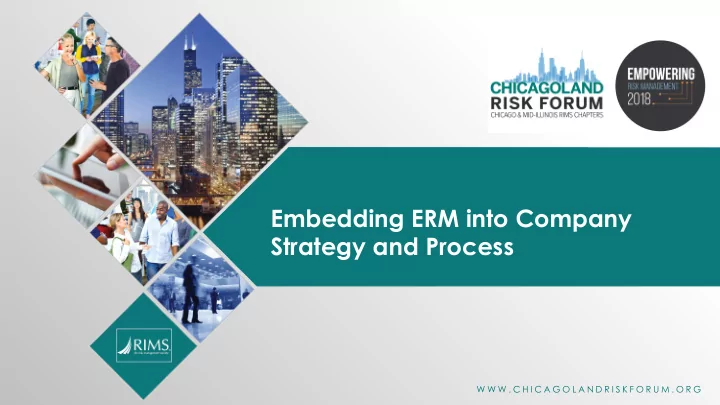

Embedding ERM into Company Strategy and Process W W W . C H I C A G O L A N D R I S K F O R U M . O R G
Session Description Many companies have implemented Enterprise Risk Management programs, but ERM truly being used strategically? This session will explore how companies can use enterprise risk management to support their strategic risk objectives. Daniel L. Weiker, Director, Enterprise Risk Management- Allegion • Frank W. Strenk, Senior Vice President Risk Management- Lockton Companies • 2
Risk and Strategic Linkage Companies implement business processes Company to support the organization in meeting its business strategic objectives. objectives Strategies to meet objectives Processes to implement strategies Identifying and mitigating those risks that can impede success is a key component of Risks strategic risk management. impeding success 3
Strategic Risk Management Principles Risk Management: • Creates/ protects organizational value • Is a part of business decision making • Is an important part of company processes • Deals with business uncertainty • Is dynamic and should be designed to fit the company 4
Strategic risk management success factors and sustainability success factors Senior management support and long-term view taken of risk management. Risk is a continuous part of strategic planning, linked to company objectives and integrated into operations. Risk appetite defined and quantified. A robust yet scalable risk assessment process in place. Risks are quantified and interrelationships identified. Risk owners are identified and held accountable. Mitigation activities independently validated. Emerging risks are identified and managed. 5 5
Making It Work One Size Does Not Fit All • Just because you have ERM does not mean you are using it • strategically – Calling it something different does not change it Strategic Risk Management is a partnership • Executive Leadership must see the value • May be a multi-year journey • – Create trust – Display value 6
Allegion’s Approach Bi-Annual Risk Survey • – Top 90 Corporate Leaders participate – Rank 30 Top Risks by Vulnerability and Impact Select Key Risks for Intensive Monitoring • – Which Risks have the highest score – Subjective Selections can be just as important Intensive Monitoring • – Each Risk assigned to one of more members of Executive Leadership Team (“ELT”) – Regular discussions with Director, Enterprise Risk Management 7
Allegion’s Approach In-Person briefings to Board and ELT • Project Based Risk Management • – Select key projects • Implement at the planning phase – Affirmatively have a conversation to discuss Risk Mitigation and planning to get ahead of problems before they occur 8
Risk Monitoring Dashboard Template 9
ERM value proposition (Example) Business Objective The company’s long range strategic objective is to expand operations geographically and by adding expanded product lines to better support customers around the globe. We will also pursue strategic acquisitions where appropriate. Risk impacting our operations can affect our ability to achieve our strategic goals and realize our mission. Enterprise risk management will support our business strategy and can enhance our ability to maintain a competitive advantage. Identify and avoid an exposure Identify and accept an Manage overall risk at a lower to our business that exposure that our competitors cost through operational competitors might miss. will avoid because they don’t efficiencies. fully understand it. The ERM process is focused on providing the processes, training, tools, and support to better identify, assess and manage the key risks that can impact the ability to achieve our business goals. 10
Risk Management Framework (example) Prioritize Risk Define Risk Ownership Drive Risk Mitigation Identify & Assess Planning & Management Measure, Monitor & Report Identification and assessment of all Detailed analysis of the risks with Assess net risk position and provide risks with prioritization (including evaluation of the root causes and data to management and team emerging risks) ability to manage members on a continuous basis Locally-Globally Leadership Support Accountability Supporting Components Risk Based Culture Risk appetite, tolerance, alignment with company goals and performance incentive plans and ongoing education Technology & Systems Means and methods of managing the ERM process S Policies & Procedures Consistent communication about a sustainable ERM process across the organization Governance & Compliance Leveraging and integrating the ERM Process with strategic planning Strategic Operational Financial Regulatory
Enterprise Risk Infrastructure (example) CEO/ Board of Directors *Typical Committee Members � Finance � Legal � HR � IT Audit Committee � Operations � Risk Management � Compliance � Supply Chain/Purchasing � Security � Internal Audit (sometimes) Enterprise Risk Enterprise Committee* Risk Manager Corporate Risks (HR, IT, Legal, etc.) Division A Division B Division C
Recommend
More recommend